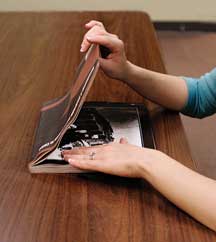Step 4: Examine the Pages
Flip through the pages (do this gently to avoid spreading spores that might be in the book you are inspecting). Sometimes mold begins to grow within the binding of a book, spreading to the pages through holes in the paper where the signatures have been stitched into the binding.
 If the book is either moist (i.e., the pages are cool to the touch when the book should be at room temperature), or shows signs of contact with liquid, then be more thorough. This may involve scanning each page of the book, looking for marks that could indicate mold growth.
If the book is either moist (i.e., the pages are cool to the touch when the book should be at room temperature), or shows signs of contact with liquid, then be more thorough. This may involve scanning each page of the book, looking for marks that could indicate mold growth.
Check for moisture: hold your hand against the paper. If it feels cool to the touch – comparatively cooler than other books or than room temperature – this is often an indication that the paper is damp, whether or not
it shows other signs of damage such as wrinkled paper or stains.
You may encounter musty (or outright moldy) odors at this stage. While odor is not always an indicator for or against mold, a book with an aroma is often a bad sign. Further, it is probably not something you want on your shelves anyway. If you do encounter an unpleasant smell, examine the book again and decide whether to keep it in the collection, regardless of the visual presence of active mold growth. See the section on coffee as a smell neutralizer in On Keeping A Mold-Infected Book for information about removing odors from books that otherwise appear fine.
Books Gone Bad - Mold in Library Collections was a project sponsored by Maine College of Art, in partnership with the Joanne Waxman Library. Funding for this project came from the Stephen and Tabitha King Foundation. The Project Lead and Artist for this project was Diane J. Wren. All contents Copyright © 2011 by Diane J. Wren. All rights reserved. No part of this web site may be reproduced or distributed in any form or by any means, electronic, mechanical, photocopying, recording, or otherwise, or stored in a data base or retrieval system, without the prior written permission of Diane J. Wren.